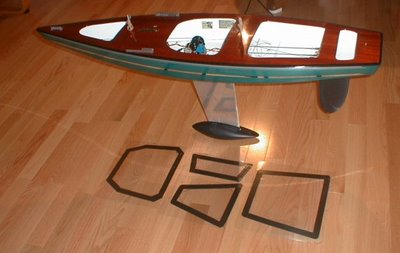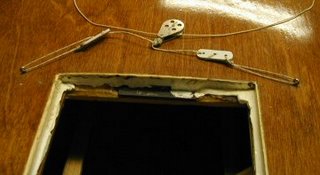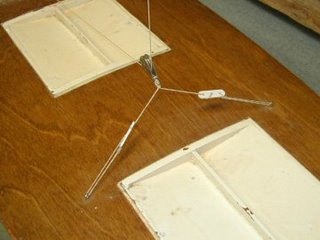by Peter Mahr and Brian Doyle
http://na.northsails.com/North_Cloth/industrial_fibers.html
Almost every piece of modern sailcloth begins life as an industrial fiber. While the brand names of many of these fibers are well known to sailors, their basic properties are less well understood. The characteristics of these fibers are an important factor to consider when choosing sails for your boat. Over the past few years there have been some significant developments in high performance fibers that have applications in sailcloth. The result is a greater variety of options for performance sailcloth makers and their customers, allowing them to select the blend of performance, durability and cost that best suits their needs.
Polyester
Polyester is today's "classic" sailcloth fiber. It is often called by the Dupont trade name DACRON® although there are other suppliers of polyester yarn used in sailcloth. Polyester is widely used for its combination of reasonably low stretch, good strength, low cost and durability. Because it can be heated and shrunk during weaving to form a tight, stable woven cloth, polyester woven sailcloth remains a good choice for cruising sails and certain racing sails. Polyester is available in many types. Dupont’s Type 52 is a "high-tenacity" premium fiber offering a balance of higher strength, lower stretch and maximum shrinkage. Other premium polyesters, with comparably excellent properties at more attractive prices, are now available from Asian and European suppliers. Their use in sailcloth has increased over the last few years at the expense of Dacron.
Nylon
Nylon is used for most downwind sails because it is strong and light. Nylon is relatively stretchy, allowing it to absorb shock loads and making it easier to fly and more stable in wavy seas than a polyester material would be. Dying this fiber is easier than any other and it is often available in a variety of colors.
Aramids
A popular class of high performance fiber in laminated sailcloth is the Aramids. The most well known aramids are Kevlar™ (a Dupont trademark) and Twaron™ (made by Teijin/Twaron of Japan). Sails made with aramid fiber are lighter than woven Dacron or Polyester laminates, and have greater effective wind ranges. The tradeoff is higher cost and shorter sail life. The stiffer Aramid fiber is more susceptible to sunlight (UV) damage and breakdown due to folding and flogging.
Aramids are produced in a number of different styles, with different balances of stretch, flex strength, weight and cost. High modulus (low stretch) types such as Kevlar 49 and Twaron 2200 are the most appropriate choice for racing sails. A variation of Kevlar called “Edge” was promoted a couple of years ago because it had slightly higher initial modulus. North’s testing revealed that this effect disappeared almost immediately with use. This type has since been discontinued.
Another aramid fiber is Technora, which is similar to medium modulus Kevlar in chemistry and performance. Initially it has a bit higher strength but loses strength more rapidly in UV making it similar in durability in most applications. It is commonly seen with a black coating, which is intended to provide some UV screening.
Vectran
Vectran is a LCP (liquid crystal polymer) fiber sold by Hoechst. Vectran’s stretch resistance is nearly as high as a standard modulus aramid, and it is somewhat stronger when new. It differs from aramids in its chemistry and has somewhat better flex resistance as long as it is shielded well from UV. Under UV exposure, it degrades more rapidly than aramids and far faster than Spectra/Dyneema.
Carbon Fiber
First used successfully in the 1992 America's Cup, carbon fiber laminates provide exceptionally low stretch and light weight at the expense of higher cost and somewhat shorter life span compared to an aramid sail. Careful R+D and on the water testing is critical with this fiber. Carbon is available in a wide variety of types, only a few of which can tolerate the flexing seen in normal sail use. Laminating techniques are also very critical to get the available high performance as well as to achieve the best possible durability. Experience over that last few years on top boats with 3DL carbon and carbon/aramid sails has been very positive and the fiber is seeing increasing use by more types of boats.
Spectra/Dyneema*
Spectra, and its European counterpart Dyneema, offer even lower stretch, higher strength, better UV resistance and much less strength loss in flex than Kevlar. However, Spectra/Dyneema sails stretch (creep) under long-term load, which makes them unacceptable for racing sails. After considerable development, this fiber is now used with excellent results in sails for large performance cruising boats.
* Note: We use the somewhat awkward ‘Spectra/Dyneema’ reference since we employ the two fibers almost interchangeably and sometimes in the same piece of cloth
PBO
At the top of the theoretical performance list is PBO, a fiber made by Japanese company Toyobo. This fiber has been used for a number of years in both 3DL and paneled sails. It has proven to be somewhat better than an aramid sail in performance when new but degrades rapidly under the combination of UV and flex. Because it is a very expensive fiber, its use in sails has all but disappeared in favor of the even higher performance and more durable carbon option.
PEN
PEN is a fiber with stretch between polyester and aramid and with slightly higher strength than polyester but far less than aramid. That combination and a cost approaching aramid have meant that this fiber has limited application in sails. It has been ruled to be polyester and as such can be used in one-design classes that limit their sails to polyester.
Summary
New fibers continue to come out of the labs. Some will become standards while others will disappear. Despite the promise of these exciting new fibers, design still plays a vital part in their successful application in your sails. Simply inserting a spicy new fiber in a poorly engineered fabric or sail design is a formula for failure. Similarly, enough of the fiber must be used to handle the sailing loads and the abuse it will take in tacking, flogging and handling. Low stretch has always been desirable in selecting fibers for sailcloth but this is only one element in a sail's performance. It is ultimately the combination of fiber, fabric and sail design that makes for a winning sail.
Fortunately for North our 3DL molded sailmaking process allows us to produce a test sail from a new fiber within a few days of its arrival at our factory in Nevada. This has allowed us to quickly evaluate new offerings and to remain the industry’s technological leader.



























